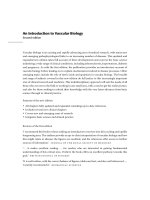introduction to japanese society, second edition
Bạn đang xem bản rút gọn của tài liệu. Xem và tải ngay bản đầy đủ của tài liệu tại đây (2.29 MB, 332 trang )
This page intentionally left blank
An Introduction to Japanese Society
Second edition
In the second edition of this book, which has become essential
reading for students of Japanese society, Yoshio Sugimoto uses
both English and Japanese sources to update and expand upon
his original narrative. In so doing, he challenges the traditional
notion that Japan comprises a uniform culture, and draws
attention to its subcultural diversity and class competition. The
author also examines what he calls “friendly authoritarianism”
– the force behind the Japanese tendency to be ostensibly
faithful to particular groups and companies. An Introduction to
Japanese Society offers a wide-ranging approach to all aspects
of Japanese society, with chapters on class, geographical and
generational variation, work, education, gender, minorities,
popular culture and the establishment.
Yoshio Sugimoto is Professor of Sociology at La Trobe Uni-
versity, Melbourne.CONTEMPORARY JAPANESE SOCIETY
Editor:
Yoshio Sugimoto, La Trobe University
Advisory Editors:
Harumi Befu, Stanford University
Roger Goodman, Oxford University
Michio Muramatsu, Kyoto University
Wolfgang Seifert, Universität Heidelberg
Chizuko Ueno, University of Tokyo
Contemporary Japanese Society provides a com-
prehensive portrayal of modern Japan through the
analysis of key aspects of Japanese society and culture,
ranging from work and gender politics to science and
technology.The series offers a balanced yet interpretive
approach. Books are designed for a wide range of
readers including undergraduate beginners in Japanese
studies, to scholars and professionals.
D. P. Martinez (ed.) The Worlds of Japanese Popular
Culture
0 521 63128 9 hardback 0 521 63729 5 paperback
Kaori Okano and Motonori Tsuchiya Education in
Contemporary Japan: Inequality and Diversity
0 521 62252 2 hardback 0 521 62686 2 paperback
Morris Low, Shigeru Nakayama and Hitoshi Yoshioka
Science,Technology and Society in Contemporary Japan
0 521 65282 0 hardback 0 521 65425 4 paperback
Roger Goodman (ed.) Family and Social Policy in
Japan: Anthropological Approaches
0 521 81571 1 hardback 0 521 01635 5 paperback
Forthcoming title:
Vera Mackie Feminism in Modern Japan: Citizenship,
Embodiment and Sexuality
0 521 82018 9 hardback 0 521 52719 8 paperback
Japanese Society
Second Edition
Yoshio Sugimoto
La Trobe University
Cambridge, New York, Melbourne, Madrid, Cape Town, Singapore, São Paulo
Cambridge University Press
The Edinburgh Building, Cambridge , United Kingdom
First published in print format
- ----
- ----
- ----
© Yoshio Sugimoto 2002
2003
Information on this title: www.cambrid
g
e.or
g
/9780521821933
This book is in copyright. Subject to statutory exception and to the provision of
relevant collective licensing agreements, no reproduction of any part may take place
without the written permission of Cambridge University Press.
- ---
- ---
- ---
Cambridge University Press has no responsibility for the persistence or accuracy of
s for external or third-party internet websites referred to in this book, and does not
guarantee that any content on such websites is, or will remain, accurate or appropriate.
Published in the United States of America by Cambridge University Press, New York
www.cambridge.org
hardback
p
a
p
erback
p
a
p
erback
eBook (EBL)
eBook (EBL)
hardback
Contents
List of Figuresviii
List of Tablesix
Preface to the First Editionxi
Preface to the Second Editionxiii
Map of Japanxiv
1The Japan Phenomenon and the Social Sciences1
2Class and Stratification:An Overview35
3Geographical and Generational Variations60
4Varieties inWork and Labor86
5Diversity and Unity inEducation115
6Gender Stratification and the Family System146
7Minority Groups:Ethnicity and Discrimination183
8Collusion and Competition in the Establishment212
9Popular Culture and Everyday Life244
10Friendly Authoritarianism271
References286
Index307
Figures
Map of Japan xiv
2.1 Class composition in terms of firm size 39
2.2 Status-consistent and inconsistent clusters 43
2.3 Changing composition of stratification clusters over time 50
2.4 Changes in the Gini index over time 52
4.1 Changes in the unionization rate 105
5.1 Disparities of age-based wages among male employees
with different educational background (2000) 116
6.1 Life-cycle model of married women 154
6.2 International comparison of female labor participation rates 155
7.1 Pyramid of the definition of “the Japanese” 188
8.1 Three-way rivalry among power centers 213
8.2 The flow of the Fiscal Investments and Loans Program 222
viii
Tables
1.1 Japan’s population distribution 2
1.2 Estimated proportions of ethnic and pseudo-ethnic
minorities in selected countries 7
1.3 Gini index of income distribution in some advanced
capitalist countries 10
1.4 Fluctuations in the frameworks and analytical tools of
Japanese studies in English-language publications 14
1.5 Four positions in the convergence debate 21
1.6 Similarities and differences in a four-person case 26
2.1 Comparison of social mobility rates among Japan,
the United States and the United Kingdom 36
2.2 International comparison of “middle class consciousness” 37
2.3 Class distribution based on Marxian categories 38
2.4 Cross-section of social stratification structure (1995) 45
2.5 Cross-tabulation of economic and cultural resources 47
2.6 Intra-class marriages in terms of partners’
educational backgrounds 54
2.7 Intra-class marriages in terms of family
occupation backgrounds 55
3.1 Differences in village structures between eastern and
western Japan 64
3.2 Some attributes of four generations 73
3.3 Changing value orientations of the Japanese:
the most congenial life-style 79
3.4 Average remaining years at the age of twenty by
occupation (male) 81
4.1 Distribution of establishments and employees in the
private sector by firm size (1999) 87
ix
4.2 Relative characteristics of large and small firms 87
4.3 Types of small businesses 89
4.4 Small businesses in manufacturing (1990) 93
4.5 Unionization rate by firm size (2001) 104
4.6 Distribution of corporatism 111
5.1 Demographic distribution of the high school student
population 119
6.1 Proportion of women in positions of power 159
6.2 Who nurses bed-ridden senior citizens at home? 160
6.3 Permeation into the lives of married women by the
capitalist and patriarchal orders 161
6.4 Decision-makers in the household 164
6.5 Four types of family 178
7.1 Characteristics of minority groups 185
7.2 Various types of “Japanese” 186
7.3 Types of burakumin 192
7.4 Four identity types of Korean youth in Japan 199
7.5 Comparative class positions of majority Japanese and
Zainichi Koreans 201
7.6 Australian citizenship rate of overseas-born by birthplace 208
8.1 Class backgrounds of the Diet members of the Liberal
Democratic Party (LDP), the Social Democratic Party
of Japan (SDP) and the Japan Communist Party (JCP) 220
8.2 Distribution of ideological orientations among major
political parties 221
8.3 Orientations of major power players 236
9.1 Comparative dimensions of three types of popular culture 245
9.2 Specific cases of marginal art 260
9.3 Characteristics of four types of culture 269
10.1 Japanese emic conceptions of social relations 282
10.2 Types of strategies for moral indoctrination 283
10.3 Some specific examples of friendly authoritarianism
in Japan 284
x Tables
Preface to the first edition
The images of Japanese society both in Japan and abroad have fluctu-
ated over time under shifting intellectual contexts. Subjected to changes
in Japan’s political economy and international status, the portrait of
Japan has swung back and forth like a pendulum between adoration
and antipathy. The theoretical framework of Japan analysis has also
fluctuated between two poles: particularistic characterizations and uni-
versalistic generalizations. Conscious of these competing perspectives,
one inevitably has to be selective in producing a general textbook. In
writing this book which delineates such a wide range of aspects of
Japanese society as generation, occupation, education, gender, minority,
and popular culture, I attempted to restore three balances in the study
of contemporary Japan.
The first of these concerns the degree of homogeneity of Japanese
society. The view that Japan comprises an extremely uniform culture
continues to be both dominant and pervasive despite several studies
which questioned and challenged this perspective in the 1980s and the
early 1990s. The competing multicultural paradigm which highlights
the internal variation and stratification of Japanese society remains
peripheral and does not appear to have received the attention it
deserves. This book makes a modest attempt to rectify this imbalance
by focussing on subcultural diversity and class competition within
Japanese society.
The second bias pertains to the continuing dominance of the so-
called group model of Japanese society, which maintains that the
Japanese are essentially faithful to their groups and uniquely oriented to
their consensual integration. While the Japanese undoubtedly show
group behavior in many situations, many questions remain unanswered
as to whether Japanese groupism is uniquely high in comparison with
other countries. It also continues to be debatable whether the Japanese
act in a groupist way in all spheres of life, whether different social
groups in Japan exhibit different levels of groupism, and whether the
Japanese behave in groups on the basis of voluntary commitment or
under the constraint of ideological manipulation. This text underscores
xi
xii Preface to the first edition
the significance of these reservations and presents a countervailing
perspective against the group model.
Finally, this book endeavors to strike a reasonable balance between
Japanese- and English-language publications as sources of information
and inspiration. Though designed as an introductory text, it invites
readers to familiarize themselves with contemporary debates and contro-
versies among Japanese analysts who write in Japanese. Many students in
the English-language world would find it difficult to read Japanese publi-
cations in Japanese, though they can pursue their interests in reading
books and articles in English. Students just beginning in Japanese
studies will benefit greatly from having a balanced understanding of both
insiders’ and outsiders’ views of Japanese society. For this purpose,
I have introduced a number of Japanese emic concepts and propositions
to demonstrate Japanese perceptions and self-images.
Financial support from the Australian Research Council enabled
me to collect and examine data for this study. Thanks to the ARC grant,
I have been able to travel several times between Melbourne and Tokyo,
live in Japan for about half of the last three years and exchange views
with Japanese academics on various issues. A fellowship from the Japan
Foundation was also instrumental in implementing the initial phase of
the study. I am grateful for the support of these organizations.
The multicultural environment in Australia where I have lived for
nearly a quarter of a century has influenced my views of Japanese
society. I am deeply indebted to the intellectual vitality of my colleagues
in Melbourne and Canberra. My partner, Machiko Sato, who has
published several books for the Japanese readership, has given me con-
tinuous encouragement, thoughtful criticism, and invaluable insight, for
which I am most thankful. I have also benefitted from many lively
discussions with my students at La Trobe University (Melbourne), Uni-
versität Heidelberg (Germany), and the University of Tsukuba (Japan)
on the points contained in this study.
Writing a book is always a liberating experience for me. I hope that
readers share some of my delight in treading the paths outlined in this
text.
Yoshio Sugimoto, 1997
xiii
Preface to the second edition
Five years is a long period in the social sciences. So many changes
have taken place in Japanese society since the publication of the first
edition of this book in 1997 that I felt obliged to update factual data and
statistical information for it to reflect Japan’s contemporary landscape
with accuracy. The structure and organization of the book remains
unchanged since there was no need to alter the framework of analysis.
Most government ministries changed their names because of the
amalgamations that took place at the beginning of 2001. In citing gov-
ernment publications in the References and Endnotes, I have used the
names of the ministries at the time of publication.
For this edition, special thanks are due to two copy editors, Justine
Norton and Karl Smith, who have kindly paid scrupulous attention to
every detail of the text.
To my pleasant surprise, this book has been used in an unexpectedly
large number of university courses around the world. I would be happy
to receive feedback from readers to improve the quality of future
editions.
Yoshio Sugimoto, 2002
Map of Japan
OKINAWA
Fukuoka
Hiroshima
Kobe
SEA
OF
JAPAN
PACIFIC
OCEAN
Hokkaido
Aomori
Iwate
Miyagi
Akita
Yamagata
Fukushima
Ibaraki
Tochigi
Gunma
Saitama
Chiba
1
2
3
4
5
6
7
8
9
10
11
12
Tokushima
Kagawa
Ehime
Kochi
Fukuoka
Saga
Nagasaki
Kumamoto
Oita
Miyazaki
Kagoshima
Okinawa
36
37
38
39
40
41
42
43
44
45
46
47
Mie
Shiga
Kyoto
Osaka
Hyogo
Nara
Wakayama
Tottori
Shimane
Okayama
Hiroshima
Yamaguchi
24
25
26
27
28
29
30
31
32
33
34
35
Tokyo
Kanagawa
Niigata
Toyama
Ishikawa
Fukui
Yamanashi
Nagano
Gifu
Shizuoka
Aichi
13
14
15
16
17
18
19
20
21
22
23
EAST JAPAN WEST JAPAN
LIST OF PREFECTURES
41
42
43
46
45
35
32
34
33
31
30
29
24
23
21
18
17
16
20
10
11
9
8
12
13
14
7
47
6
5
3
2
1
4
15
19
22
25
28
26
37
38
39
36
44
40
27
Sendai
Sapporo
SHIKOKU
KYUSHU
HONSHU
HOKKAIDO
0 100 km
N
Kyoto
Osaka
Nagoya
Tokyo
Yokohama
1 The Japan Phenomenon and the
Social Sciences
I Multicultural Japan
1 Sampling Problem and the Question of Visibility
Hypothetical questions sometimes inspire the sociological imagination.
Suppose that a being from a different planet arrived in Japan and
wanted to meet a typical Japanese, one who best typified the Japanese
adult population. Whom should the social scientists choose? To answer
this question, several factors would have to be considered: gender,
occupation, educational background, and so on.
To begin, the person chosen should be a female, because women
outnumber men in Japan; the 2000 census shows that sixty-five million
women and sixty-one million men live in the Japanese archipelago.With
regard to occupation, she would definitely not be employed in a large
corporation but would work in a small enterprise, since fewer than one
in eight workers is employed in a company with three hundred or more
employees. Nor would she be guaranteed lifetime employment, since
those who work under this arrangement amount at most to only a
quarter of Japan’s workforce. She would not belong to a labor union,
because only one out of five Japanese workers is unionized. She would
not be university-educated. Fewer than one in six Japanese have a uni-
versity degree, and even today only about 40 percent of the younger
generation graduate from a university with a four year degree. Table 1.1
summarizes these demographic realities.
The identification of the average Japanese would certainly involve
much more complicated quantitative analysis. But the alien would come
closer to the “center” of the Japanese population by choosing a female,
non-unionized and non-permanent employee in a small business with-
out university education than a male, unionized, permanent employee
with a university degree working for a large company.
When outsiders visualize the Japanese, however, they tend to think of
men rather than women, career employees in large companies rather
than non-permanent workers in small firms, and university graduates
1
rather than high school leavers, for these are the images presented on
television and in newspaper and magazine articles. Some academic
studies have also attempted to generalize about Japanese society on the
basis of observations of its male elite sector, and have thereby helped to
reinforce this sampling bias.
1
Moreover, because a particular cluster of
individuals who occupy high positions in a large company have greater
access to mass media and publicity, the lifestyles and value orientations
of those in that cluster have acquired a disproportionately high level of
visibility in the analysis of Japanese society at the expense of the wider
cross-section of its population.
2 Homogeneity Assumptions
While every society is unique in some way, Japan is particularly unusual
in having so many people who believe that their country is unique.
2
Regardless of whether Japan is “uniquely unique” in sociological and
psychological reality, the overwhelming preponderance of Japanese
publications arguing for its uniqueness is, in itself, unique. The so-
called group model of Japanese society represents the most explicit and
coherent formulation of this line of argument and remains the most
2 An Introduction to Japanese Society
Table 1.1 Japan’s population distribution
Variables Majority Minority
Gender
a
Female: 65.0 million (51%) Male: 61.9 million (49%)
Employees by Small firms – less than 300 Large firms – 300 or more:
firm size
b
employees: 44.5 million (78%) 12.5 million (22%)
Educational Those without university University graduates:
background
c
education: 81.4 million (85%) 14.5 million (15%)
Union membership Non-unionists: Unionists: 11.5 million (21%)
in labor force
d
42.3 million (79%)
Sources:
a Population census conducted in 2000.
b The Establishment Census conducted by the Management and Coordination Agency
in 1996. The data cover all private-sector establishments except individual proprietor-
ship establishments in agriculture, forestry and fishery.
c Population census conducted in 2000. University graduates do not include those who
have completed junior college and technical college. Figures do not include pupils
and students currently enrolled in schools and pre-school children.
d Labor Union Basic Survey, conducted by the Ministry of Labour in 2000.
influential framework for interpreting the Japanese and Japanese social
structure. Put most succinctly, the model is based upon three lines of
argument.
First, at the individual, psychological level, the Japanese are portrayed
as having a personality which lacks a fully developed ego or inde-
pendent self. The best-known example of this claim is Doi’s notion of
amae which refers to the allegedly unique psychological inclination
among the Japanese to seek emotional satisfaction by prevailing upon
and depending on their superiors.
3
They feel no need for any explicit
demonstration of individuality. Loyalty to the group is a primary value.
Giving oneself to the promotion and realization of the group’s goals
imbues the Japanese with a special psychological satisfaction.
Second, at the interpersonal, intra-group level, human interaction is
depicted in terms of Japanese group orientation. According to Nakane,
for example, the Japanese attach great importance to the maintenance
of harmony within the group. To that end, relationships between
superiors and inferiors are carefully cultivated and maintained. One’s
status within the group depends on the length of one’s membership in
the group. Furthermore, the Japanese maintain particularly strong
interpersonal ties with those in the same hierarchical chain of command
within their own organization. In other words, vertical loyalties are
dominant. The vertically organized Japanese contrast sharply with
Westerners, who tend to form horizontal groups which define their
membership in terms of such criteria as class and stratification that cut
across hierarchical organization lines.
4
Finally, at the inter-group level, the literature has emphasized that
integration and harmony are achieved effectively between Japanese
groups, making Japan a “consensus society”. This is said to account for
the exceptionally high level of stability and cohesion in Japanese society,
which has aided political and other leaders in their efforts to organize or
mobilize the population efficiently. Moreover, the ease with which the
energy of the Japanese can be focused on a task has contributed in no
small measure to Japan’s remarkably rapid economic growth during the
half-century since the war. From a slightly different angle, Ishida argues
that inter-group competition in loyalty makes groups conform to
national goals and facilitates the formation of national consensus.
5
For decades, Japanese writers have debated on the essence of “Japan-
eseness.” Numerous books have been written under such titles as What
are the Japanese? and What is Japan?
6
Many volumes on Nihon-rashisa
(Japanese-like qualities) have appeared.
7
Social science discourse in
Japan abounds with examinations of Nihon-teki (Japanese-style)
tendencies in business, politics, social relations, psychology, and so on.
Some researchers are preoccupied with inquiries into the “hidden
Japan and the Social Sciences 3
shape,”
8
“basic layer,” and “archetype”
9
of Japanese culture. These
works portray Japanese society as highly homogeneous, with only
limited internal variation, and give it some all-embracing label.
Hamaguchi, for example, who presents what he calls a contextual
model of the Japanese, maintains that the concept of the individual is
irrelevant in the study of the Japanese, who tend to see the interpersonal
relationship itself (kanjin) – not the individuals involved in it – as the
basic unit of action.
10
Amanuma argues that the Japanese core person-
ality is based on the drive for ganbari (endurance and persistence),
which accounts for every aspect of Japanese behavior.
11
Publishing in
Japanese, a Korean writer, Lee, contends that the Japanese have a
unique chijimi shiko¯, a miniaturizing orientation which has enabled them
to skillfully miniaturize their environment and products, ranging from
bonsai plants, small cars, and portable electronic appliances to
computer chips.
12
The list of publications which aim to define Japanese
society with a single key word is seemingly endless and, although the
specific appellation invariably differs, the reductive impulse is
unchanged.
At least four underlying assumptions remain constant in these
studies. First, it is presumed that all Japanese share the attribute in
question – be it amae or miniature orientation – regardless of their
class, gender, occupation, and other stratification variables. Second, it is
also assumed that there is virtually no variation among the Japanese in
the degree to which they possess the characteristic in question. Little
attention is given to the possibility that some Japanese may have
it in far greater degree than others. Third, the trait in question, be it
group-orientation or kanjin, is supposed to exist only marginally in
other societies, particularly in Western societies. That is, the feature is
thought to be uniquely Japanese. Finally, the fourth presupposition
is an ahistorical assumption that the trait has prevailed in Japan for an
unspecified period of time, independently of historical circumstances.
Writings based on some or all of these propositions have been published
in Japan ad nauseam and have generated a genre referred to as Nihon-
jinron (which literally means theories on the Japanese). Although some
analysts have challenged the validity of Nihonjinron assertions on
methodological, empirical, and ideological grounds,
13
the discourse has
retained its popular appeal, attracting many readers and maintaining a
commercially viable publication industry.
The notion of Japan being homogeneous goes in tandem with the
claim that it is an exceptionally egalitarian society with little class
differentiation. This assertion is based on scattered observations of
company life. Thus, with regard to resource distribution, some contrast
the relatively modest salary gaps between Japanese executive managers
4 An Introduction to Japanese Society
and their employees with the marked discrepancy between the salaries
of American business executives and their workers. Focusing on the
alleged weakness of class consciousness, others point out that Japanese
managers are prepared to get their hands dirty, wear the same blue
overalls as assembly workers in factories and share elevators, toilets, and
company restaurants with low-ranking employees.
14
Still others suggest
that Japanese managers and rank-and-file employees work in large
offices without status-based partitions, thereby occupying the work-
place in an egalitarian way. Furthermore, public opinion polls taken by
the Prime Minister’s Office have indicated that eight to nine out of ten
Japanese classify themselves as middle class. While there is debate as to
what all these figures mean, they have nevertheless strengthened the
images of egalitarian Japan. A few observers have gone as far as to
call Japan a “land of equality”
15
and a “one-class society.”
16
Firmly
entrenched in all these descriptions is the portrayal of the Japanese as
identifying themselves primarily as members of a company, alma mater,
faction, clique, or other functional group, rather than as members of a
class or social stratum.
3 Diversity and Stratification
The portrayal of Japan as a homogeneous and egalitarian society is,
however, contradicted by many observations that attest to it being a
more diversified, heterogeneous, and multicultural society than this
stereotype suggests.
17
This book presents these facets of Japanese
society in some detail, examining the country’s regional, generational,
occupational, and educational varieties as well as gender and minority
issues. It does not try to claim that Japan is unusually diversified or
exceptionally stratified in comparison with other industrialized
societies, but challenges the view that it is uniquely homogeneous and
egalitarian. The central idea here is simple and modest: Japan does not
differ fundamentally from other countries in its internal variation and
stratification, though some of its specific manifestations and concrete
forms may contrast with those in Western societies.
The image of multicultural Japan may sit uncomfortably with the
relatively homogeneous racial makeup of Japanese society, yet sub-
cultures do proliferate on a number of non-racial dimensions, such as
region, gender, age, occupation, education, and so forth. To the extent
that subculture is defined as a set of value expectations and lifestyles
shared by a section of a given population, Japanese society indeed
reveals an abundance of subcultural groupings along these lines. As a
Japan and the Social Sciences 5
conglomerate of subcultures, Japan may be viewed as a multicultural
society, or a multi-subcultural society. Furthermore, most subcultural
units are rank-ordered in terms of access to various resources, including
economic privilege, political power, social prestige, information, and
knowledge. In this sense, Japan is a multistratified society as well. Let us
now take a preliminary look at some concrete illustrations of these
multicultural and multistratified features of Japanese society. Each point
will be scrutinized in more detail in later chapters.
(a) Subcultural Diversity
Contrary to the widely held view, Japan has an extensive range of
minority issues, ethnic and quasi-ethnic, which proponents of the
homogeneous Japan thesis tend not to address. One can identify several
minority groups in Japan even if one does so narrowly, referring only to
groups subjected to discrimination and prejudice because of culturally
generated ethnic myths, illusions, and fallacies.
In Hokkaid¯o, the northernmost island of the nation, over twenty
thousand Ainu live as an indigenous minority.Their situation arose with
the first attempts of Japan’s central regime to unify the nation under its
leadership around the sixth and seventh centuries and to conquer the
Ainu territories in northern Japan. In addition, some three million
burakumin are subjected to prejudice and many of them are forced to
live in separate communities, partly because of an unfounded myth that
they are ethnically different.
18
Their ancestors’ plight began in the feudal
period under the Tokugawa shogunate which ruled the nation for two
and a half centuries from the seventeenth century and institutionalized
an outcast class at the bottom of a caste system. Though the class was
legally abolished after the Meiji Restoration in 1868, discrimination and
prejudice have persisted. Some six hundred thousand Koreans form the
biggest foreign minority group in Japan. Their problem originated with
Japan’s colonization of Korea at the beginning of the twentieth century,
and the Japanese importation of Koreans as cheap labor for industries.
A similar number of foreign workers, both documented and undocu-
mented, live in the country as a result of their influx into the Japanese
labor market since the 1980s, mainly from Asia and the Middle East, in
their attempt to earn quick cash in the appreciated Japanese yen.
Finally, over 1.2 million Okinawans, who live in the Ryukyu islands at
the southern end of Japan, face occasional bigotry based on the belief
that they are ethnically different, and incur suspicion because of the
islands’ longstanding cultural autonomy.
The estimated total membership of these groups is about five million,
which represents some 4 percent of the population of Japan.
19
If one
6 An Introduction to Japanese Society
includes those who marry into these minority groups and suffer the
same kinds of prejudice, the number is greater. In the Kansai region
where burakumin and Korean residents are concentrated, the propor-
tion of the minority population exceeds 10 percent. These ratios may
not be as high as those in migrant societies such as the United States,
Canada and Australia,
20
but they seem inconsistent with the claim that
Japan is a society uniquely lacking minority issues. These issues tend to
be obfuscated, blurred, and even made invisible in Japan partly because
the principal minority groups do not differ in skin color and other bio-
logical characteristics from the majority of Japanese.
In international comparison, Japan does not rank uniquely high in its
composition of minority groups which exist because of their ethnicity
or the ethnic fictions that surround them. Table 1.2 lists some of the
nations whose ethnic minority groups constitute less than 10 percent.
Given that the Japanese figure is 4 percent, Japan’s position would be
somewhere in the second band; it is certainly difficult for it to be in the
top band. To be sure, different societies define minority groups on
the basis of different criteria, but that is exactly the point. Japan seems
to be unique, not in its absence of minority issues, but in the decisive-
ness with which the government and other organizations attempt to
ignore their existence.
Regional variation is perhaps the most obvious form of diversity in
Japan.The nation is divided into two subcultural regions, eastern Japan
with Tokyo and Yokohama as its center, and western Japan with Osaka,
Kyoto, and Kobe as its hub. The two regions differ in language, social
relations, food, housing, and many other respects. The subcultural
Japan and the Social Sciences 7
Table 1.2 Estimated proportions of ethnic and pseudo-ethnic minorities in selected
countries
Level Minority groups in the Specific countries
total population
Band 1 0–3% Austria, Bangladesh, Denmark,
Dominican Republic, Greece, Iceland,
Korea (North), Korea (South), Libya,
Portugal
Band 2 3–6% Czech, Finland, Germany, Haiti, Japan,
Lebanon, Liberia, Netherlands
Band 3 6–11% Albania, Cambodia, China, Egypt,
Mongolia, Romania, Sweden
Note: Calculated from Famighetti (1994).
differences between the areas facing the Pacific and those facing the Sea
of Japan are also well known. Japan has a wide variety of dialects. A
Japanese from Aomori Prefecture, the northernmost area of Honshu¯
Island, and one from Kagoshima, the southernmost district in Kyu¯shu¯
Island, can scarcely comprehend each other’s dialects. Different
districts have different festivals, folk songs, and local dances. Customs
governing birth, marriage, and death differ so much regionally that
books explaining the differences are quite popular.
21
The exact degree of
domestic regional variation is difficult to assess in quantitative terms
and by internationally comparative standards, but there is no evidence
to suggest that it is lower in Japan than elsewhere.
Japanese language is a diversity-conscious tongue. Even if one does
not assume any direct correlation between language and culture, one
must acknowledge that Japanese, which is sensitive to diversity, reflects
Japan’s cultural patterns to a considerable extent. Japanese is a sexist
language, differentiating between male and female vocabulary, expres-
sions, and accents. The male language is supposed to be coarse, crude,
and aggressive, while the female language is expected to be soft, polite,
and submissive.
22
Even at the level of self-identification, the male
expressions for “I”, boku, ore, and washi, differ from their more formal
and refined female counterparts, watashi and watakushi. Japanese is
also a hierarchy-oriented language. Honorific expressions are essential
ingredients of everyday Japanese conversation, in which one must
always be attentive to the social status of the person to whom one talks,
noting whether the addressee is higher or lower in the social hierarchy.
Without assuming that Japanese is exceptional in these regards, it can
be postulated that the Japanese are at least heedful of a variety of status
groups and their respective cultural orientations.
Conscious of the lifestyle differences of various groups, the Japanese
often refer in everyday vocabulary to a variety of subcultural groupings
using the term zoku, a suffix that literally means a tribe. Cases in point
include: shay¯o-zoku, those employees who have the privilege of using
company expense accounts to enjoy drinking, eating, playing golf, and
other entertainments with their clients after working hours; madogi-
wazoku (the window-gazing tribe), those company employees who have
come to the end of their career in middle age, have few tasks to
perform, and sit near the window away from the center of activity in a
large, Japanese-style, non-partitioned office; and b¯os¯o-zoku, the bikers
who produce noise pollution in a quiet neighborhood.
In addition to these long-standing variations in Japanese society, there
are strong indications that its degree of diversity is rapidly increasing
in some areas. Specifically, the patterns of Japanese consumer behavior
became diversified in a fundamental way in the 1980s. Previously,
8 An Introduction to Japanese Society
manufacturers sold models standardized for mass consumption, success-
fully promoting them through sales campaigns and advertisements.
Recently, however, this strategy has become ineffective because
consumers have begun to take an interest in products in tune with their
personal preferences. They have become more unpredictable, selective,
and inquisitive. The notion of the Japanese as uniform mass consumers
does not effectively account for their consumer behavior patterns today.
Numerous Japanese popular writings published in the 1980s and
early 1990s paid attention to the variety and even stratification of
Japanese lifestyles. Market analysts, for instance, were quick to point
out the increasing diversity of the consumer market. A consumer
behavior study
23
suggests the emergence of sh¯oshu¯ – individualized,
divided, and small-unit masses – as opposed to taishu¯, the undifferenti-
ated, uniform, and large-scale masses. The research institute of
Hakuh¯od¯o,
24
a leading advertising agency, also argued that the notion
of bunshu¯ (segmented masses) would account for the behavior of
consumers more effectively than the conventional view of them as a
homogeneous entity. Kinkonkan, a best-seller produced by Kazuhiro
Watanabe and Tarako Productions, classifies the everyday behavior of
the Japanese as either marukin (the moneyed type) or marubi (the needy
type), a caricaturized taxonomy which has attained a wide circulation.
These concepts perhaps reflected some entrenched and emerging
patterns of Japanese society, as the popularized notions, buzzwords, and
catchphrases that they produced struck a responsive chord in the hearts
of many readers who found they somehow represented reality.
Gender differences in value orientation are arguably more pro-
nounced than ever with the gradual rise of feminist consciousness at
various levels. Opinion surveys have consistently shown that more
women than men disagree with the notion of home being the woman’s
place.The proportion of women who feel that marriage is not necessary
if they can support themselves invariably outnumbers that of men.
25
Women show much more commitment than men to welfare, medical,
educational, consumer, and other community activities.
26
These observations of social diversification and segmentation, and of
the polarization of lifestyles, imply that Japanese society is not as class-
less and egalitarian as the conventional theory of Japan suggests; it is
not only diversified horizontally but also stratified vertically like other
societies of advanced capitalism.
(b) Social Stratification and Class Reproduction
Comparative studies of income distribution
27
suggest that Japan cannot
be regarded as uniquely egalitarian. On the contrary, it ranks as one of
Japan and the Social Sciences 9









